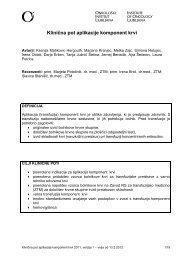Create successful ePaper yourself
Turn your PDF publications into a flip-book with our unique Google optimized e-Paper software.
Characterization of cystatin F and its possible role in<br />
immune system regulation<br />
Toma` Langerholc 1 , Boris Turk 1 and Janko Kos 1,2<br />
1<br />
Department of Biochemistry and Molecular Biology, Jo`ef Stefan Institute, Ljubljana,<br />
Slovenia; 2 University of Ljubljana, Faculty of Pharmacy, Ljubljana, Slovenia<br />
Cystatin F is a cysteine protease inhibitor expressed mainly in cells important for<br />
immune response. Glycosylation, six cysteine residues instead of four and not too<br />
potent inhibition of cysteine proteases make cystatin F different from other members<br />
in the type II cystatin family. A large proportion of cystatin F resides inside the cells<br />
in lysosomes, where it might have a role in regulating cysteine protease activity in<br />
processes of antigen presentation.<br />
In our previous study [1] we showed that monomeric cystatin F is a general inhibitor<br />
of cysteine proteases with endoprotease activity. Inhibitory potential is abrogated in<br />
disulfide bonded dimers, which are predominantly found in the cells. Dimerization<br />
is mediated by one or both cysteines in positions 7 and 43, which are additional<br />
in respect to other type II cystatins. In monomeric cystatin F these two cysteine<br />
residues might form the third intramolecular disulfide bond by stretching the<br />
N-terminal along the α-helix on the surface of the molecule. Dimerization of cystatin<br />
F may be a mechanism for the regulation of inhibitory activity of cystatin F. The<br />
presence of the inhibitor in the dimeric form results in increased cysteine protease<br />
activity, which could affect the variability of antigen epitopes presented on MHC II<br />
molecules on the surface of antigen presenting cells, a mechanism which is crucial<br />
also in anti-tumour immune response.<br />
In the baculovirus expression system we prepared wild type cystatin F along with<br />
92p20<br />
three mutants C7S, C43S and (C7S, C43S) and purified them to homogeneity. Cysteine<br />
to serine mutants did not prevent the inhibitor to fold. Inhibitory constants were<br />
determined for the interactions of cystatin F with cysteine proteases and the cysteine<br />
residues involved in intermolecular disulfide bond formation were identified.<br />
[1] Langerholc T, Zavasnik-Bergant V, Turk B, Turk V, Abrahamson M, Kos<br />
J. (2005) Inhibitory properties of cystatin F and its localization in U937<br />
promonocyte cells. FEBS J. Mar; 272(6): 1535-45.

















